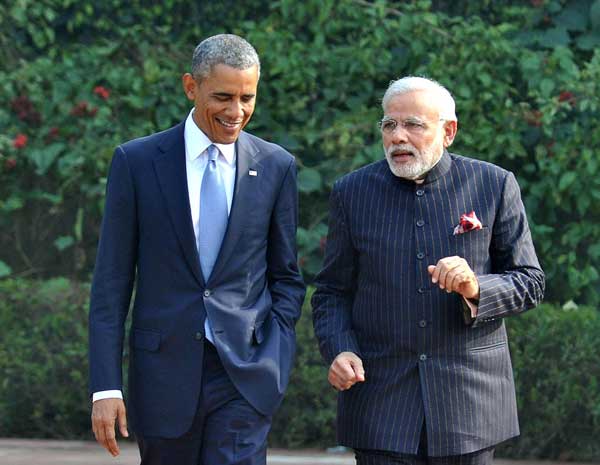IDR Blog
Asia Pivot Doctrine: Changing Dynamics of US Foreign Policy
The “Pivot to Asia” doctrine marks a decisive shift in the US foreign policy-thinking in recent times. In terms of scope, purpose and resources mobilised for policy action, it is potentially more powerful than the previous “War on Terror” policy that defined American strategy since the beginning of this millennium. First articulated by Hillary Clinton in 2011, who incidentally is contending for the next US presidential elections, the Pivot to Asia strategy has gained considerable traction and seeks to reaffirm US pre-eminence in international affairs in the wake of Chinese economic and military ascendance.
The ultimate objective is to stop the Chinese juggernaut from becoming a major threat and tame it to have a skewed balance of power in favour of the US.
The doctrine essentially envisages a rebalance of US relationships vis-a-vis Asian state actors and a restructuring of priorities for the American foreign policy establishment. The US’ political attention will increasingly shift from Euro-Atlantic region to the Indo-Pacific region, particularly focusing on East Asian states in order to contain the Chinese meteoric rise. With global power dynamics rapidly transforming and Cold War politics turning into a relic of the past, the US now identifies its interests in the eastern hemisphere as more valuable and exacting than in the west.
China Threat
The Asia Pivot policy adopts a multidimensional approach encompassing economic, political and security issues to strengthen US engagement with Asian states. It advocates multilateralism with strong emphasis on trade and economic partnerships (for instance the Transpacific Partnership) while subtly combining hard power and soft power instruments to gain predominance in the Indo-Pacific region. The ultimate objective is to stop the Chinese juggernaut from becoming a major threat and tame it to have a skewed balance of power in favour of the US.
Indeed, the US realises that China is neither an ideological threat nor has any expansionist agenda, unlike the erstwhile Soviet Union. China in fact has embraced global capitalist ideology cherished by the US and is becoming a leading player in industrial and financial sectors. Its stewardship in establishing multilateral institutions, trading agreements and executing large-scale transnational infrastructural projects, in spite of US aversions, has given Beijing the image of next superpower-in-the-making which the Americans obviously resent. While Chinese military capacity is way behind the US, nevertheless, its growing regional and extra regional clout directly challenges American traditional influence and hence containing China is becoming utmost priority for the US.
While Chinese military capacity is way behind the US, nevertheless, its growing regional and extra regional clout directly challenges American traditional influence and hence containing China is becoming utmost priority for the US.
Given the financial and military constraints, Washington is prudently divesting its political capital from conventional regions like Eurasia and Middle-East and consolidating its efforts towards the Asia Pivot. It is also reshaping its policy perspectives towards its friends and foes spread across several regions. An analysis of US’ response to major international events unfolding in the past few months testifies this proposition. From Crimean annexation to Iranian nuclear negotiations to the Cuban entente, Washington’s behaviour is not insignificantly guided by its overarching medium-term goal of anchoring itself in the Indo-Pacific region.
US Response
When compared to sending military warships to the South China Sea in the wake of Chinese aggressive behaviour, the US response to Crimean crisis appears relatively platitude. Except for imposing economic sanctions and providing soft material support to the Ukrainian regime, Washington did not play a trouble-shooter role as it did during the Kosovo crisis. Ukraine was in fact a member-in-waiting to join the US-led NATO alliance and despite this Russia had a cake-walk in annexing the Crimean territory. Evidently, the US calculation was not to antagonise Russia to the extent of cementing a Moscow-Beijing nexus against it.
Similarly, notwithstanding Israel’s ferocious opposition to the Iranian nuclear negotiations, the US yielded to diplomatic engagement with Tehran concluding an apparent win-win deal for all parties. However, Iran is still tagged with the infamous ‘axis of evil’ label and it is intriguing as to why the US conceded to such soft term deal-making with its arch rival at a time when it neither faces oil crunches nor was Iranian nuclear programme a serious threat post-stuxnet attack. Moreover, the US nuclear non-proliferation agenda has been virtually stagnant for decades after the failed CTBT talks. It may be noted here that, Iran has strong backing from China and the sanctions against it were choking businesses of even friendly US allies like EU and India. Indeed, by continually isolating Iran and pushing it to the brink, the US would have closed political options for the moderate regime in Tehran thereby increasing the latter’s dependence on rival countries like China. Clearly, this goes against US interests and hence it sensibly eased its hardline position against Iran.
…the US seeks to regain its global supremacy by investing in regions where it is facing stiff competition…
The US-Cuba entente is a remarkable development as it ends one of the last dreadful vestiges of the Cold War era. Even as the same old communist regime reigns in Havana, the US has removed Cuba from the list of rogue states and endorses deeper bilateral cooperation between the two. How could have this dramatic turnaround happened? While there is no singular explanation, growing Chinese presence in Latin America might certainly have been a factor for US policy-makers. Over the years, China has become the second largest trading partner for Latin American countries, including Cuba, and the continent has seen steady increase of Chinese investments in areas like oil exploration and manufacturing. A low-key military cooperation also exists between Beijing and some Latin American countries. Given these conditions, the US could not possibly allow hostile intrusions in its sphere of influence and hence strengthening the good-old American continental bonding is deemed crucial. The Cuban entente appears a necessary course correction in that direction.
To sum it up, the US seeks to regain its global supremacy by investing in regions where it is facing stiff competition and in this regard its short term foreign policy priorities have dynamically transformed. Classical realism teaches us that to contain a greater enemy it is prudent to co-opt the smaller ones. Washington seems to be precisely doing this.
Post your Comment
4 thoughts on “Asia Pivot Doctrine: Changing Dynamics of US Foreign Policy”
 Loading Comments
Loading Comments





Nice article Krupa. This is Pavan from Srirams. Contact back.
Good work Krupakar. Looking forward to read what gains will India achieve from this Asia Pivot Policy.
Great Post. Interesting report on Asia’s perspective on US foreign policy.
Also a great read will be this article on remittance to Asia published by money transfer comparison site Sendthatcash
Impressive work mr.krupakar.looking forward to see more of your work